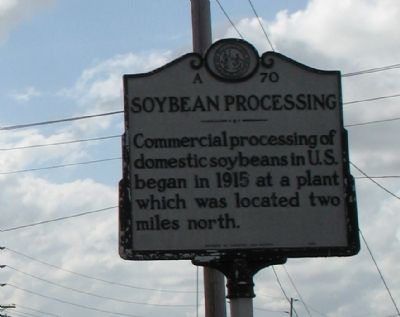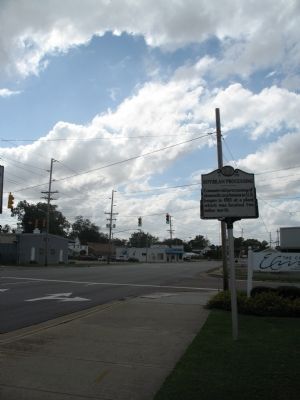Elizabeth City in Pasquotank County, North Carolina — The American South (South Atlantic)
Soybean Processing
Erected 1982 by Division of Archives and History. (Marker Number A-70.)
Topics and series. This historical marker is listed in this topic list: Agriculture. In addition, it is included in the North Carolina Division of Archives and History series list. A significant historical year for this entry is 1915.
Location. 36° 17.82′ N, 76° 13.248′ W. Marker is in Elizabeth City, North Carolina, in Pasquotank County. Marker is on East Water Street (U.S. 17) near Mcmorrine Street, on the left when traveling east. Touch for map. Marker is in this post office area: Elizabeth City NC 27909, United States of America. Touch for directions.
Other nearby markers. At least 8 other markers are within walking distance of this marker. Culpeper’s Rebellion (about 700 feet away, measured in a direct line); Joseph C. Price (about 800 feet away); J. C. B. Ehringhaus (about 800 feet away); Battle of Elizabeth City (approx. 0.2 miles away); Pasquotank River (approx. 0.2 miles away); Wright Brothers in the Albemarle (approx. 0.2 miles away); A Town Divided (approx. 0.2 miles away); a different marker also named Wright Brothers in the Albemarle (approx. 0.2 miles away). Touch for a list and map of all markers in Elizabeth City.
Regarding Soybean Processing. With the boll weevil taking its toll on North Carolina’s cotton industry, the Elizabeth City Oil and Fertilizer Company, incorporated to manufacture cottonseed oil and other cotton by-products, tried its hand at a new commodity on December 13, 1915. At that time, under the management of William Thomas Culpepper, the company crushed approximately 20,000 bushels of soybeans, generating the first commercially produced domestic soybean oil in the country. The manufacture of the soybean oil was completed without a single alteration in existing equipment. Both the oil and the residual “cake,” usually ground into meal, were highly marketable. Other oil mills, in towns such as Winterville, New Bern, Farmville, and Wilson, began working with soybean oil shortly thereafter. The advent of domestic soybean processing made the easily grown plant popular throughout North Carolina.
The soybean was first planted in America in the late 1800s as forage for livestock. In 1904, George Washington Carver discovered that the soybean was a good source of protein and oil. He also learned, in experimenting with crop rotation, that planting soybeans for two years actually helped improve the soil conditions for later cotton crops. Following such research, soybean production increased. The plants flourish in North Carolina’s hot, humid summers, and as of 2002, the state ranks fifteenth in the nation in soybean yields. At the time of the first processing in Elizabeth City, North Carolina was the leading producer of the legume.
The oil processing plant was located on property at the junction of Ehringhaus and McMorrine Streets in Elizabeth City. It is no longer standing.
References:
• Biennial Report of the North Carolina Department of Agriculture, 1914–1916
• United States Department of Agriculture, Yearbook (1917)
• (Elizabeth City) The Advance, November 30 and December 17, 1915
• R. W. Judd and A. H. Probst, Soybeans: Improvement, Production, and Uses (1973)
• North Carolina Soybean Producers Association website: http://www.ncsoy.org
Copied from the North Carolina Department of Cultural Resources
Credits. This page was last revised on July 1, 2021. It was originally submitted on October 1, 2007, by Laura Troy of Burke, Virginia. This page has been viewed 1,309 times since then and 20 times this year. Photos: 1, 2. submitted on October 1, 2007, by Laura Troy of Burke, Virginia. • J. J. Prats was the editor who published this page.

